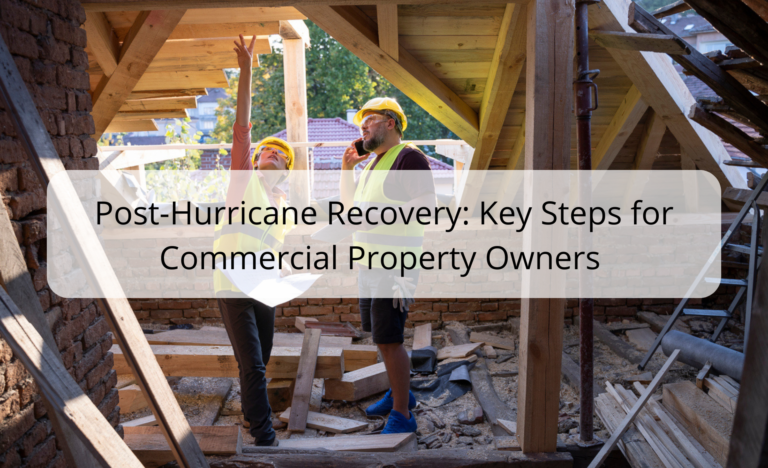Hurricanes are some of the most devastating natural disasters, causing significant destruction to commercial properties. For business owners, the aftermath of a hurricane can feel overwhelming. Damage assessment, navigating insurance claims, and restoring operations are crucial but often daunting tasks. While the road to recovery can be long, taking the right steps early on can help minimize losses and ensure your business is back on track as quickly as possible.
Prioritize Safety
In the immediate aftermath of a hurricane, the safety of your employees, customers, and anyone on your property should be your top priority. Hurricanes can cause severe structural damage, flooding, and power outages, all of which pose safety risks.
Before re-entering your building, assess the area for any visible signs of structural damage, such as collapsed walls, roof damage, or large cracks. If you notice significant damage, it may not be safe to enter. Additionally, be cautious of electrical hazards, such as downed power lines or submerged electrical systems, and if you smell gas, evacuate immediately and contact the appropriate authorities.
Once you’ve ensured that it’s safe to re-enter the property, proceed with caution. If you’re unsure of the building’s safety, contact local authorities or hire a professional inspector to clear the building for safe access.
Document the Damage
After ensuring the safety of everyone on the property, documenting all visible damage is the next critical step. Proper documentation is vital for filing insurance claims and receiving full compensation for the damage your business has sustained.
Use your smartphone or camera to take clear photos and videos of all damaged areas, both inside and outside the building. Pay close attention to structural issues, such as roof damage, broken windows, and water damage. Additionally, document any damage to equipment, inventory, and furnishings. Writing detailed notes about the condition of each area will help you during the insurance claims process. Make sure to also note any impact on business operations, such as equipment that is no longer functional or areas that are no longer usable. Maintaining a thorough record of all damage will help support your insurance claim and ensure that no loss goes unnoticed.
Work with a Public Adjuster
A public adjuster can be a valuable ally for commercial property owners navigating the Post-Hurricane Recovery. Unlike the insurance company’s adjuster, a public adjuster works on behalf of the policyholder to ensure a fair settlement. They assess the damage, handle documentation, and negotiate directly with the insurance company, advocating for the best possible outcome.
Hiring a public adjuster is especially beneficial when dealing with extensive damage, complex claims, or if you feel the insurance company’s offer is too low. They are experts in identifying all losses, including structural damage, business interruption, and equipment losses. Since public adjusters typically work on a contingency basis, their fee is a percentage of the final settlement, which motivates them to secure the highest possible compensation for you.
To ensure you choose the right public adjuster, look for someone with experience, proper licensing, and a track record of successful claims. By working with a public adjuster, you can streamline the claims process and focus on rebuilding while they advocate on your behalf.
Prevent Further Damage
While waiting for news from your insurance company, it’s essential to take steps to prevent further damage to your property. Most insurance policies require property owners to mitigate additional damage after the initial event. Failing to do so could reduce the payout on your claim. For example, if your building has broken windows, board them up to prevent further water intrusion or theft. If your roof has been damaged, place a tarp over the affected area to minimize water damage. If there’s standing water inside the building, use pumps or shop vacuums to remove it, and use fans to dry out affected areas as much as possible.
Keep receipts for any materials you purchase to protect the property and any labor costs associated with mitigating further damage. These expenses may be reimbursed as part of your claim.
Begin Cleanup and Restoration
Once your property has been documented and the Insurance Adjuster has visited, you can begin the cleanup and restoration process. Depending on the extent of the damage, you may need to hire professional restoration contractors to handle water extraction, debris removal, and structural repairs.
Be selective when hiring contractors. Look for licensed and insured companies with experience in Hurricane Recovery. Getting multiple quotes will help you secure fair pricing, but always prioritize the reputation and reliability of the contractor. Unlicensed contractors often surface after disasters, so it’s crucial to vet each candidate thoroughly.
Throughout the cleanup and restoration, maintain communication with your insurance company to ensure that all repair work is covered by your claim. Keep detailed records of all repair work and associated costs to ensure smooth reimbursement.
Plan for Business Continuity
While restoring the physical structure of your property is crucial, it’s equally important to plan for business continuity. The longer your business remains closed, the greater the impact on your bottom line, even with insurance coverage.
If your building is severely damaged and uninhabitable, you may need to relocate temporarily. Research alternative office spaces or retail locations to keep your operations going during the restoration process. If a physical location is unnecessary for your business, allowing employees to work remotely can help maintain productivity.
Additionally, keep clients, vendors, and suppliers informed about your business status. Transparency about potential delays or interruptions can help maintain strong relationships with your stakeholders throughout the recovery process.
Evaluate and Strengthen Future Preparedness
Once your business is back up and running, it’s time to evaluate your hurricane preparedness plan and identify areas for improvement. No recovery process is perfect, and the aftermath of a hurricane presents a valuable opportunity to strengthen your future disaster response.
Review your insurance coverage to ensure it meets the needs of your business, including whether you need to add coverage for floods or business interruptions. If your property is in a high-risk area, consider making structural improvements, such as reinforcing the roof, installing storm shutters, or upgrading drainage systems to better withstand future hurricanes.
Finally, revise your emergency preparedness plan to account for lessons learned during the recent hurricane. Ensure that all employees are trained on evacuation procedures, emergency communication protocols, and their roles in the event of a future disaster.
Remain Resilient Despite Hurricane Damage
Recovering from hurricane damage can be overwhelming, but taking the right steps will help protect your business and expedite the restoration process. From ensuring safety to documenting damage and working closely with your insurance company, every decision you make is crucial to your recovery. If you want to maximize your claim and ensure that every aspect of your property loss is properly addressed, working with an experienced public adjuster can make all the difference.
At D.A. Lamont, our team of skilled public adjusters is dedicated to helping commercial property owners navigate the complexities of hurricane damage claims. We’ll handle the details, advocate on your behalf, and ensure you receive the compensation you deserve. If your business has been impacted by a hurricane, don’t wait—contact us today to schedule a consultation and let us help you get back on your feet.


